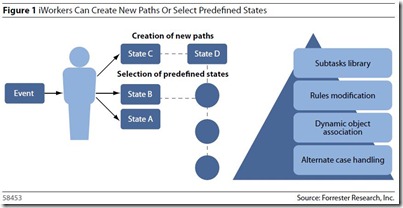I’ve been thinking a lot recently about all the stuff that happens outside of traditional enterprise applications. Enterprise software (ERP, CRM, etc) has become good at solving most of the structured work needs in organizations. But, many business problems today require work outside of enterprise applications. These ‘white space’ activities involve research, analysis , collaboration, applied knowledge, planning, resource allocation, approvals and many other human activities. Often they get managed today using email. This results in a large portion of the work done in organizations being:
- Undocumented
- Unmanaged
- Unmeasured
- Time Intensive
Alternatively, they are supported with custom development that makes changes and upgrades difficult (often in addition the above issues.)
This need cries out for something that is easy to use like email, but addresses its deficiencies. Adaptive Case Management (ACM) holds out the hope of solving this need, but I’m not sure anyone has yet met the vision and been able to deliver on the promise. I’m not even sure there is agreement on the title (Advanced, Dynamic, or Adaptive) let alone what the promise is.
Forrester recently Waved Dynamic Case Management (DCM). After a long discussion of what DCM is, they evaluate vendors (mostly incumbent BPMS providers) on only six capabilities:
- Design
- Development environment
- Capture, CCM, and ECM support and security
- Case handling and guidance
- Case-centric application support
- Automation and event management
More enlightened definitions, I think, come from practitioners a little closer to the field:
Keith Swenson lists six characteristics of an Adaptive Process:
- simplified deployment: the case templates do not need to be designed in advance to fit the situation. You deploy an uncustomized system into the organization, and then it is adapted by the case managers themselves as needed.
- exercise: The system is not “designed” by a central planner, but instead it is trained by exercising it. Those parts that get the most use, and have the most need of improvement, will get the most effort.
- learning: the system as a whole learns how to support the organization. Instead of designing for a theoretical idealized business case, it learns from the real business cases, with the real people working on them.
- practice: the training is accomplished by doing the work, and without the need to make an abstract theory about the underlying mechanisms.
- stability: the system can be extremely stable because it senses and responds to perturbations automatically. The case managers themselves can shift behavior as needed, without waiting for programmers or other specialists.
- optimized: each part of the organization can optimize use to their particular needs, for their particular part of the business, and their particular employees and skills. This level of optimization can only be achieved through self-modification.
Max Pucher simplifies and then expands these ideas (I encourage all to read the full content of all posts referenced here.) He uses three criteria to define an Adaptive Process:
- Adaptive Process is a productive system that deploys not only the organization and process structure but through backend interfaces becomes the system of record for the business data entities and content involved. All processes are completely transparent as per access authorization and fully auditable.
- Adaptive Process enables non-technical business users in virtual organizations to seamlessly create/consolidate structured and unstructured processes from basic predefined business entities, content, social interactions, and business rules to achieve verifiable goals.
- Adaptive Process moves the process knowledge gathering in the life cycle from the template analysis/modeling/simulation phase into the process execution. The AP system collects actionable knowledge – without intermediate analysis phase – based on process patterns created by business users.
He then goes on to catalogue increasing levels of ACM that deliver these capabilities:

He concludes by emphasizing that, “The ACM platform must allow each business and department to work as they see fit to achieve customer outcomes and avoid the failure demand and increased costs that process standardization would cause.”
Who will deliver on any of these ideas is still up for grabs in my estimation. Some social tools are starting to hit close to these promises, but none have quite hit the mark . Let me know who you think gets close.

Thanks for the really good coverage of ACM. Let me just point out that our Papyrus Platform provides the complete spectrum of Strategic ACM. There are several products that provide Baisc and Full ACM functionality today.
If you are interested we can schedule a demo whenever you see the need. Thanks again! Max Pucher – Chief Architect ISIS Papyrus Software
LikeLike
Great post, thanks for the reference.
-Keith Swenson
LikeLike
Very resonant post Jon. Thank you
LikeLike